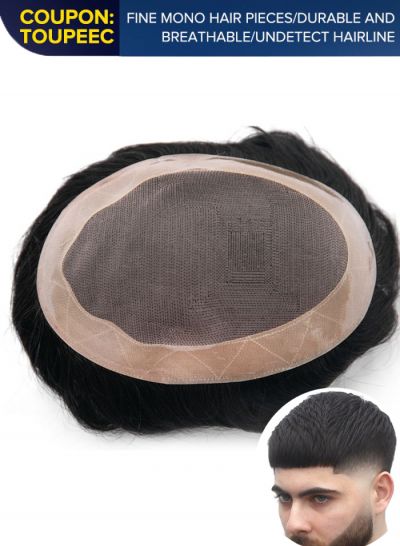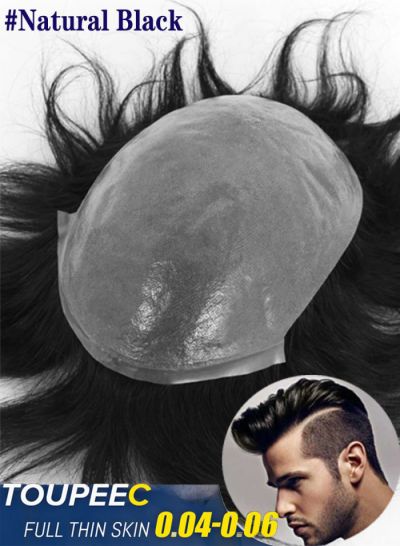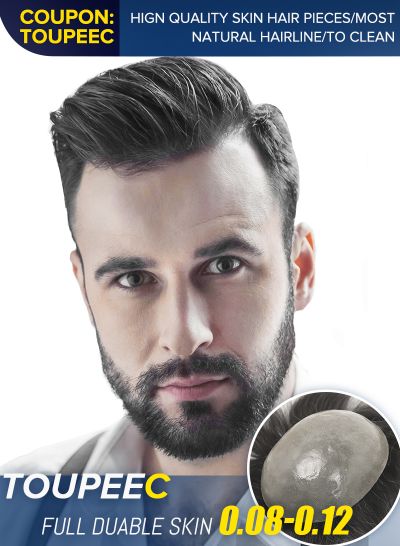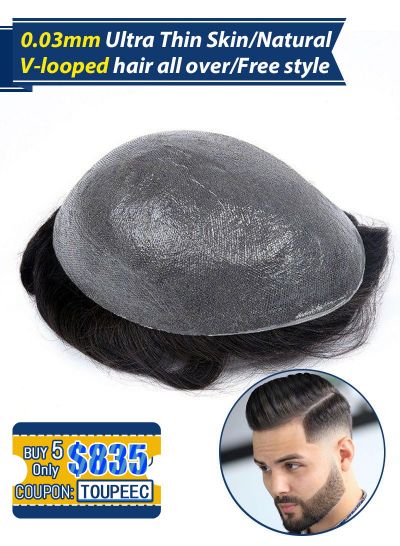Comparison of hair transplant and non-surgical hair replacement systems
What's the difference between a hair transplant and a hair replacement system?
More and more people suffer from hair loss, and the nature of hair loss is becoming more and more serious. In the toupee industry, it is inevitable that there will be new customers who discover the hair system for the first time, and may ask you: what is the difference between a hair transplant and non-surgical hair replacement system, and which is the better choice? In this article, we'll give you an overview of hair transplant and non-surgical hair replacement systems so that you'll have all the knowledge you share with your customers to help them make informed decisions about the best hair loss solution for them.
Hair transplant:
First, we need to understand what a hair transplant is and what the process involves. Studies have shown that no matter what causes hair loss, the area where hair usually falls is usually the front of the head, while the back and side hair is almost always intact. Therefore, once normal blood circulation is established, the hair can grow by moving healthy hair follicles to the place where the hair falls. This is the basic principle of hair transplantation. You can say it's a bit like robbing Peter of Paul's money. It doesn't increase the amount of hair, it just moves healthy hair follicles where you need them most.
Depending on the size of the transplant area, the procedure takes about four to eight hours. It's usually done in the surgeon's own consulting room. First, the surgeon cleans the patient's scalp and injects the patient to numb the back of the head where the hair follicles are to be extracted. There are two methods of transplantation: follicular unit transplantation and follicular unit extraction。
With follicular unit transplantation, surgeons can remove 6 to 10 inches of skin from the back of the head. Then they will stitch the scalp, and the stitches will be hidden by the surrounding hair. Next, surgeons divide the removed scalp strips into 500 to 2000 tiny grafts - each with a single hair or just a few hairs. If it's follicular unit extraction, the surgeon will shave off the hair on the patient's scalp and remove it from the follicles there one by one. The area will merge to cover the dots of the existing hair. After that, the two processes are the same. After the graft is ready, the surgeon cleans and numbs the area of hair loss, punches or cuts the gap with a scalpel or needle, and finally places each graft delicately in one of the holes.
New hair developed by hair transplantation has the same biological characteristics as normal hair. Therefore, new hair can be scraped, dried, burned, dyed, and can grow and shed normally. Since the hair follicles in the posterior occipital region (the posterior part of the head) are not affected by the male recipient, after successful transplantation, the hair follicles still retain the characteristics of the original hair follicles, and will not die or fall off. So, in theory, the outcome of hair follicle transplantation can last a lifetime. However, can hair transplantation fundamentally solve the problem of hair loss? This problem is more complicated. The final answer depends on the individual, the quality of the follicle, the skill of the doctor, and the final survival rate of the follicle.
In addition, it should be pointed out that there are three types of people who are not suitable for hair transplantation.
People who have experienced hair loss:
It is very important to understand the essence of hair loss. Some hair loss symptoms are serious, but only short-term, although the effect can last for months or even as long as two years. However, most patients can fully recover, so there is no need for hair transplants. It's best to wait until the hair loss is stable before making a decision.
Patients with severe baldness:
Hair transplants only redistribute autologous hair follicles. In other words, hair follicles cannot be taken from others. However, people with severe baldness can't provide enough donor hair follicles, so they can't carry out hair transplantation.
Newly cured burn and scald patients:
Due to the weak subcutaneous tissue (innermost layer), blood supply is seriously damaged, and it is unable to provide the right environment and nutrition for the healthy growth of hair follicles. The survival rate of hair follicles will also be greatly reduced.
If you are in the hair replacement industry, there is no doubt that these are the people you should position. But what is a non-surgical hair replacement system?
Non surgical hair replacement system:
When people first heard about hair systems, they mistakenly associated them with old-fashioned toupees, which were rough on the skin, never looked good, and were always easy to find. But the non-surgical hair replacement system we're talking about today is very sophisticated, hand woven, and as natural as real hair. In fact, someone around your new customer is likely to be wearing the hair system all the time without realizing it.
The hair system consists of two parts: the basic part and the hair. The base will be in direct contact with the customer's scalp. It is usually made of two materials: lace and poly (or skin). Lace is more durable and breathable. Poly, on the other hand, is more difficult to detect and more natural. Customers can choose the right materials according to their needs. In most cases, the material of hair is real human hair, and hair types include: Indian hair, Chinese hair, Brazilian hair, European hair, etc. Sometimes synthetic hair is also used. Factory workers use special hair ventilation techniques to manually tie one or more hairs to the base. After fixation, the final toupee will be perfectly integrated with the customer's own hair, and the overall effect is very realistic.
What's the difference between a hair transplant and a hair replacement system?
The most obvious difference is that one is a surgical solution and the other is a non-surgical solution.
First of all
we should be aware of the risks of any operation. Hair transplants are no exception. In addition to bleeding and infection, there are also scars and unnatural growth of new hair. Due to infection, the patient may also suffer from the loss of new hair grafts or even sudden loss (called shock loss), but over time, new hair will regenerate.
Secondly
at the end of the operation, the whole scalp looks very ugly and bloody. When new hair grows, people face a recovery period of about six months or more. Therefore, hair transplantation is not an immediate solution.
In addition, the results and final appearance of the hair implant are uncontrollable. There is no "simulation test" for patients. They have to wait until the end of the process to see the results. The success of hair transplantation depends largely on the quality of the donor hair. If the quality of the hair is poor, it may never achieve the desired appearance. As we all know, the cost of hair transplantation is very expensive, some people may not be able to afford such a high cost at a time.
Different from the non-surgical hair replacement system, people can get immediate results. Whether they have hereditary alopecia, male / female alopecia, chemical alopecia or any other condition, wearing a hair system can solve all of these problems. toupees have no restrictions on matching their own hair: customers can choose any color, style, density, texture or length according to their own situation or preference. After receiving the toupee, customers can put on the toupee themselves, or go to the barber shop or salon to get the perfect appearance. Fixing tools include hair replacement glue and tape, clips or hair bands, but there is little risk in the whole process. (a small number of customers may be allergic to some components of hair gel, but this is not a big problem because of the presence of anti allergic gel.)
The only drawback of hair systems is that they are not permanent, and different base materials and hair ventilation methods have different lifespan. When the toupee is seriously damaged, your customer will need to replace it with a new toupee, but as a result, you can get the benefits of a new look hair system. In addition, non-surgical hair replacement systems are much cheaper than non-surgical hair replacement systems, and people will not be limited by just one hairstyle - they can change hairstyles at any time.
Therefore, due to its versatility and economic price, non-surgical hair replacement system has become an increasingly attractive alternative to hair transplantation.














